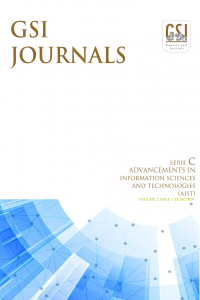Abstract
References
- Akyılmaz, O, Ayan, T, Özlüdemir, T, 2003. Geoid surface approximation by using Adaptive Network Based Fuzzy Inference Systems, AVN p. 308 – 315.
- Çakır, L. ve Yılmaz, N. (2014). Polynomials, radial basis functions and multilayer perceptron neural network methods in local geoid determination with GPS/levelling. Measurement 57, 148–153.
- Eteje Sylvester O., Oduyebo Olujimi F. and Olulade Sunday, A. (2018). Procedure for the Determination of Local Gravimemetric – geometric Geoid Model. International Journal of Advances in Scientific Research and Engineering. Volume 4, Issue 8, 205-214.Jyh- Shing, R J, 1995. Neuro – fuzzy modelling and control, Proceedings of the IEEE, 83, No:3, 378-406.
- Kavzaoğlu, T., Saka, M.H., 2005. Modelling local GPS/Levelling geoid undulations using artificial neural networks. Journal of Geodesy 78, 520–527.
- Kotsakis C, Sideris MG, 1999. On the adjustment of combined GPS/levelling/ geoid networks. J Geod 73:412–421.
- Pepe, M., Prezioso, G., & Santamaria, R. (2015). Impact of vertical deflection on direct georeferencing of airborne images. Survey Review, 47(340), 71-76.
- Rosa, R., Jana, S.K., Das, R.K. and Pal, D.K. (2016). Evaluation of orthometric heights from GPS survey using a geoid model– a case study for madang, Papua New Guinea. International Journal of Advancements in Research & Technology, Volume 5, Issue 5, 9-16.
- Seager J, Collier P, Kirby J, 1999. Modelling geoid undulations with an artificial neural network. IIEEE, International Joint Conference on Volume 5, 3332 – 3335.
- Shen, W., & Han, J. (2013). Improved geoid determination based on the shallow-layer method: a case study using EGM08 and CRUST2.0 in the Xinjiang and Tibetan Regions. Terrestrial, Atmospheric & Oceanic Sciences, 24(4), 591-604.
- Torge W, 1980. Geodesy. Walter de Gruyter, Berlin.
- Yılmaz, M., Arslan, E., 2010, “Adaptive network based on fuzzy inference system estimates of geoid heights interpolation”, Scientific Research and Essays Vol. 5(16), 2148-2154.
- Yılmaz, M., Arslan, E., 2011, “Effect of increasing number of neurons using artificial neural network to estimate geoid heights”, International Journal of the Physical Sciences Vol. 6(3), 529-533.
Abstract
Ortometrik yükseklikler pek çok
mühendislik, jeodezik ve CBS uygulamaları için gerekli olan yüksekliklerdir. Ortometrik
yükseklik geoidden itibaren çekül doğrultusu boyunca yükseklik ölçmeleri ile
belirlenir. Öte yandan elipsoidal yükseklik, büyüklüğü ve şekli tanımlanan
(WGS84 gibi) bir elipsoidde elipsoid normalinden itibaren ölçülür ve GPS,
GLONASS gibi uydu teknikleri ile belirlenir. Elipsoidal yükseklik ile
ortometrik yükseklik arasındaki farka geoid yüksekliği denir. Uydu teknikleri ve ölçmeleri alanındaki
gelişmeler sayesinde elipsoidal yükseklik ortometrik yüksekliği göre daha ucuz
ve kolay bir şekilde belirlenebilmektedir. Bu yüzden, bu iki yükseklik
sistemleri arasındaki dönüşüm parametresi olan geoid yüksekliğinin belirlenmesi
çok önemlidir. Eğer belirli bir bölge için geoid yüksekliği presizyonlu bir
şekilde belirlenebilirse, ortometrik yükseklikler elipsoidal yüksekliklerden
kolayca ve presizyonlu bir şekilde elde edilebilir. Bu nedenle, bu dönüşüm
ortometrik yüksekliklerin elde edilmesinde hem paradan hem de zamandan tasarruf
yapılmasına imkân sağlar. Son yıllarda bulanık mantık ilkeleri pek çok jeodezik
problemin çözümünde kullanılmaktadır. Bu
çalışmada, bulanık mantık yönteminde yaygın olarak kullanılan Sugeno yöntemine
göre geoid hesabının yapılışı açıklanmıştır. Uygulama olarak da Tekirdağ il
sınırları içerisinde bulunan toplam 262 nokta ile en uygun bulanık modeli
bulmak için 4 farklı alt küme ile hesap yapılmıştır. Sonuçlar değerlendirilmiş ve
bölge için bulanık mantık yönteminin geoid hesabı için kullanılabileceği
gösterilmiştir.
References
- Akyılmaz, O, Ayan, T, Özlüdemir, T, 2003. Geoid surface approximation by using Adaptive Network Based Fuzzy Inference Systems, AVN p. 308 – 315.
- Çakır, L. ve Yılmaz, N. (2014). Polynomials, radial basis functions and multilayer perceptron neural network methods in local geoid determination with GPS/levelling. Measurement 57, 148–153.
- Eteje Sylvester O., Oduyebo Olujimi F. and Olulade Sunday, A. (2018). Procedure for the Determination of Local Gravimemetric – geometric Geoid Model. International Journal of Advances in Scientific Research and Engineering. Volume 4, Issue 8, 205-214.Jyh- Shing, R J, 1995. Neuro – fuzzy modelling and control, Proceedings of the IEEE, 83, No:3, 378-406.
- Kavzaoğlu, T., Saka, M.H., 2005. Modelling local GPS/Levelling geoid undulations using artificial neural networks. Journal of Geodesy 78, 520–527.
- Kotsakis C, Sideris MG, 1999. On the adjustment of combined GPS/levelling/ geoid networks. J Geod 73:412–421.
- Pepe, M., Prezioso, G., & Santamaria, R. (2015). Impact of vertical deflection on direct georeferencing of airborne images. Survey Review, 47(340), 71-76.
- Rosa, R., Jana, S.K., Das, R.K. and Pal, D.K. (2016). Evaluation of orthometric heights from GPS survey using a geoid model– a case study for madang, Papua New Guinea. International Journal of Advancements in Research & Technology, Volume 5, Issue 5, 9-16.
- Seager J, Collier P, Kirby J, 1999. Modelling geoid undulations with an artificial neural network. IIEEE, International Joint Conference on Volume 5, 3332 – 3335.
- Shen, W., & Han, J. (2013). Improved geoid determination based on the shallow-layer method: a case study using EGM08 and CRUST2.0 in the Xinjiang and Tibetan Regions. Terrestrial, Atmospheric & Oceanic Sciences, 24(4), 591-604.
- Torge W, 1980. Geodesy. Walter de Gruyter, Berlin.
- Yılmaz, M., Arslan, E., 2010, “Adaptive network based on fuzzy inference system estimates of geoid heights interpolation”, Scientific Research and Essays Vol. 5(16), 2148-2154.
- Yılmaz, M., Arslan, E., 2011, “Effect of increasing number of neurons using artificial neural network to estimate geoid heights”, International Journal of the Physical Sciences Vol. 6(3), 529-533.
Details
| Primary Language | Turkish |
|---|---|
| Journal Section | Articles |
| Authors | |
| Publication Date | August 5, 2019 |
| Published in Issue | Year 2019 Volume: 2 Issue: 1 |


